Related Research Articles

The San Francisco Municipal Railway ( MEW-nee; SF Muni or Muni), is the primary public transit system within San Francisco, California. It operates a system of bus routes, the Muni Metro light rail system, three historic cable car lines, and two historic streetcar lines. Previously an independent agency, the San Francisco Municipal Railway merged with two other agencies in 1999 to become the San Francisco Municipal Transportation Agency (SFMTA). In 2018, Muni served 46.7 square miles (121 km2) with an operating budget of about $1.2 billion. Muni is the seventh-highest-ridership transit system in the United States, with 142,168,200 rides in 2023, and the second-highest in California after the Los Angeles County Metropolitan Transportation Authority.

The San Francisco Chronicle is a newspaper serving primarily the San Francisco Bay Area of Northern California. It was founded in 1865 as The Daily Dramatic Chronicle by teenage brothers Charles de Young and Michael H. de Young. The paper is owned by the Hearst Corporation, which bought it from the de Young family in 2000. It is the only major daily paper covering the city and county of San Francisco.

Muni Metro is a semi-metro system serving San Francisco, California, United States. Operated by the San Francisco Municipal Railway (Muni), a part of the San Francisco Municipal Transportation Agency (SFMTA), Muni Metro served an average of 68,700 passengers per weekday in the first quarter of 2023, making it the seventh-busiest light rail system in the United States.

Civic Center/UN Plaza station is a combined BART and Muni Metro rapid transit station in the Market Street subway in downtown San Francisco. Located under Market Street between 7th Street and 8th Street, it is named for the Civic Center neighborhood and the adjacent United Nations Plaza. The three-level station has a large fare mezzanine level, with separate platform levels for Muni Metro and BART below.
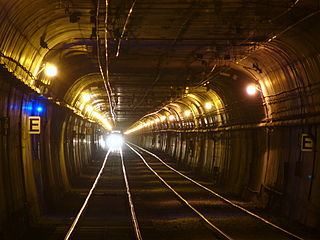
The Twin Peaks Tunnel is a 2.27-mile-long (3.65 km) light rail/streetcar tunnel in San Francisco, California. The tunnel runs under Twin Peaks and is used by the K Ingleside, M Ocean View and S Shuttle lines of the Muni Metro system.
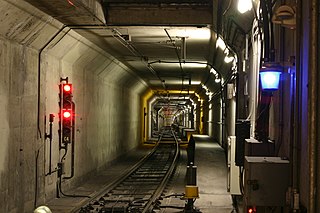
The Market Street subway is a two-level subway tunnel that carries Muni Metro and BART trains under Market Street in San Francisco, California. It runs under the length of Market Street between Embarcadero station and Castro station. The upper level is used by Muni Metro lines and the lower level is used by BART lines. BART does not run through the whole subway; it turns south and runs under Mission Street southwest of Civic Center/UN Plaza station. The northeastern end of the BART level is connected to the Transbay Tube. On the Muni Metro level, the southwestern end of the Market Street subway connects to the much-older Twin Peaks Tunnel, and the northeastern end connects to surface tracks along the Embarcadero.

Balboa Park station is a Bay Area Rapid Transit (BART) station and Muni Metro complex in the Mission Terrace neighborhood of San Francisco, California, located near the eponymous Balboa Park. It is an intermodal hub served by four BART routes, three Muni Metro lines, and a number of Muni bus routes. The station complex also includes two rail yards, Cameron Beach Yard and Green Light Rail Center, where Muni maintains Muni Metro trains and heritage streetcars. BART uses a below-grade island platform on the west side of the complex; Muni Metro routes use several smaller side platforms located on surface-level rail loops around the yards.

The E Embarcadero is a historic streetcar line that is the San Francisco Municipal Railway's second heritage streetcar line in San Francisco, California. Trial service first ran during the Sunday Streets events on The Embarcadero in 2008. The line initially ran on weekends only, but expanded to weeklong service in late April 2016.
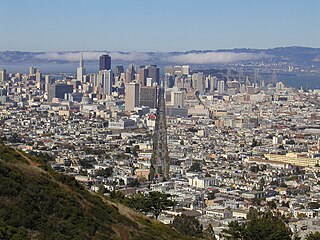
Market Street is a major thoroughfare in San Francisco, California. It begins at The Embarcadero in front of the Ferry Building at the northeastern edge of the city and runs southwest through downtown, passing the Civic Center and the Castro District, to the intersection with Portola Drive in the Twin Peaks neighborhood. Beyond this point, the roadway continues into the southwestern quadrant of San Francisco. Portola Drive extends south to the intersection of St. Francis Boulevard and Sloat Boulevard, where it continues as Junipero Serra Boulevard.

Market Street Railway is San Francisco Municipal Railway's (Muni) 1,200-member non-profit preservation partner. It relies on private contributions to help maintain San Francisco’s fleet of historic streetcars in service on the E Embarcadero and F Market & Wharves lines.

50 Beale Street is a 328 ft (100 m), 23-floor high-rise office building in the Financial District, San Francisco between Market Street and Mission Street. It is on the list of tallest buildings in San Francisco.

The 47D Drake was a PCC trolley line that was part of the Pittsburgh Light Rail system.
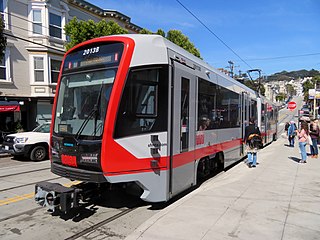
With five different modes of transport, the San Francisco Municipal Railway runs one of the most diverse fleets of vehicles in the United States. Roughly 550 diesel-electric hybrid buses, 300 electric trolleybuses, 250 modern light rail vehicles, 50 historic streetcars and 40 cable cars see active duty.
The San Francisco and San Mateo Electric Railway (SF&SM) was the first electric streetcar company in San Francisco, California. The company was only in business for ten years, starting from 1892 until it was merged into the United Railroads of San Francisco (URR) in 1902.

Don Chee Way and Steuart station is a light rail station in San Francisco, California, United States, serving the San Francisco Municipal Railway's F Market & Wharves heritage railway line. It is located on Don Chee Way, a streetcar right-of-way, between Steuart Street and The Embarcadero and serves as the station for the San Francisco Railway Museum.

The San Francisco trolleybus system forms part of the public transportation network serving San Francisco, in the state of California, United States. Opened on October 6, 1935, it presently comprises 15 lines and is operated by the San Francisco Municipal Railway, commonly known as Muni, with around 300 trolleybuses. In San Francisco, these vehicles are also known as "trolley coaches", a term that was the most common name for trolleybuses in the United States in the middle decades of the 20th century. In 2023, the system had a ridership of 42,240,000, or about 132,300 per weekday as of the fourth quarter of 2023.

The San Francisco Historic Trolley Festival was a heritage streetcar service along Market Street in San Francisco, California, United States. It used a variety of vintage streetcars and operated five to seven days a week, primarily in summer months, between 1983 and 1987. Sponsored by the San Francisco Chamber of Commerce and operated by the San Francisco Municipal Railway, it was the predecessor of the F Market & Wharves heritage streetcar line that opened in 1995. It used historic streetcars from several different countries, as well as a number of preserved San Francisco cars. The impetus behind the Trolley Festival was that the city's famed cable car system, one of its biggest tourist attractions, was scheduled to be closed for more than a year and a half for renovation, starting in September 1982. The Trolley Festival was conceived as a temporary substitute tourist attraction during the cable car system's closure.
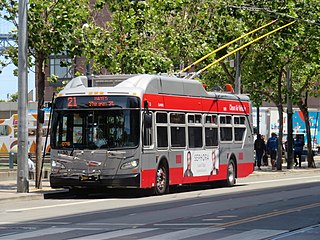
21 Hayes is a trolleybus line operated by the San Francisco Municipal Railway (Muni). It connects the Civic Center to the neighborhoods northeast of Golden Gate Park in San Francisco.
References
- 1 2 3 "2011 Silver SPUR Awards: How Rick Laubscher Put SF's History to Work for the Future". San Francisco Bay Area Planning and Urban Research Association. November 1, 2011. Retrieved December 20, 2018.
- ↑ "OBITUARY -- Fred H. Laubscher". SF Gate . September 4, 1997. Retrieved 2018-12-20.
- ↑ Holmes 2017 , p. 11
- ↑ Holmes 2017 , p. 38
- 1 2 3 Holmes 2017
- ↑ Holmes 2017 , p. 98
- ↑ Republished article: Franz, Justin (January 20, 2019). "A direct line to the past: The streetcars of San Francisco" . Retrieved February 12, 2019– via The Spokesman-Review. Original article: Franz, Justin (December 14, 2018). "In San Francisco, visitors and locals ride the rails as they did a century ago" . The Washington Post . Retrieved February 12, 2019.
- ↑ "About Market Street Railway". Streetcar.org. San Francisco Market Street Railway. 2018. Retrieved 2018-12-20.